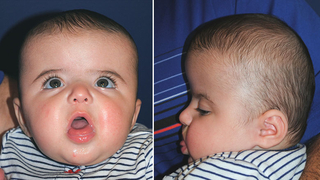What is Muenke syndrome?
Muenke syndrome, also known as FGFR3-associated coronal synostosis syndrome, is a genetic disorder characterized by the anomalies if the skull and face. Gene mutations are the cause if these skull and face differences.
Individuals with Muenke syndrome typically have the following conditions:
- Craniosynostosis: early closure of one or more of the seams between the skull bones, causing an abnormal skull. This results in a skull shape with increased vertical height. Typically, one or both coronal sutures (the seams that run from ear to ear over top of the head and meet at the soft spot in the middle) are fused, causing a very tall forehead and wide, short skull.
- Midface hypoplasia: decreased growth of the midface. This does not typically contribute to obstructive sleep apnea and airway concerns.
- Hypertelorism: wide-set eyes.
The upper face and eyes of patients with Muenke syndrome may be similar to patients with other forms of syndromic craniosynostosis, but they typically do not develop midface hypoplasia or retrusion of the midface that requires surgery. Hand and limb anomalies are also uncommon in this syndrome. Down-slanting palpebral fissures (the area between the open eyelids), droopy eyelids (ptosis) and high arch palate are often noted.

Muenke syndrome complications and treatment
Patients with Muenke syndrome may be at greater risk for elevated intracranial pressure than other syndromes, and hearing loss is much more frequently encountered.
At Children's Hospital of Philadelphia, we have a comprehensive Craniofacial Program where patients are seen by the following specialties:
- Plastic surgeons: craniofacial and hand surgeons
- Oral surgeons
- Neurosurgeons
- Otolaryngologists (ear, nose and throat specialists)
- Pediatric dentists
- Craniofacial-trained orthodontists
- Geneticists
- Speech and language pathologist
- Audiologist
- Psychologists
- Advanced Practice Providers (nurse practitioners and physician assistants)
- Nurses
- Pulmonary Medicine
The treatment of Muenke syndrome is dependent upon both functional and appearance-related needs, and should be addressed immediately after your child is born. Because of the complex issues that can be associated with Muenke syndrome, your child should be treated at a medical center that includes the pediatric specialists across the many clinical areas your child may need.
At Children’s Hospital of Philadelphia, coordinated care of patients with Muenke syndrome is typically managed through the Craniofacial Program, working closely with the Center for Pediatric Airway Disorders to address breathing issues, as well as the Pediatric Feeding and Swallowing Center to manage feeding issues. Eye protection or balance issues, such as strabismus, are coordinated through the Division of Ophthalmology.
Because every patient with syndromic craniosynostosis has unique problems, the timing and course of surgical treatment is highly individualized. It is important to see a surgeon with expertise in pediatric plastic, reconstructive and oral surgery who specializes in treating these rare conditions. Learn more about the surgical treatment approach for syndromic craniosynostosis.
As your child grows, she should also have access to psychosocial support services to address any mental, social or psychological issues that accompany these conditions.
Watch our educational video to learn more about the services and treatment options CHOP offers to children with craniofacial conditions such as Muenke syndrome.
Resources to help
Muenke Syndrome Resources
Craniofacial Program Resources
We have gathered resources to give you information and help you find answers to your questions. We hope this makes your family's life a little easier.
Reviewed by Scott P. Bartlett, MD, Jesse A. Taylor, MD
